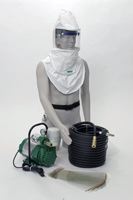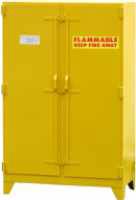July 28, 1992
Mr. Darrell K. Mattheis
Organization Resources Counselors, Inc.
1910 Sunderland Place, N.W.
Washington, D.C. 20036
Dear Mr. Mattheis:
This is in further response to your letter of January 23 to Patricia K. Clark, Director, Directorate of Compliance Programs, requesting interpretations of the Occupational Safety and Health standard for spray painting under 29 CFR 1910.107(n), relating to vehicle maintenance operations. Please accept our apologies for the delay in responding.
It is important to note the source standard for 29 CFR 1910.107 is NFPA No. 33-1969, Standard for Spray Finishing Using Flammable and Combustible Materials, which was most recently revised in 1989. The OSHA standard is applicable; however, compliance with NFPA No. 33-1989 is acceptable so long as equal or greater protection is provided. Our responses to your questions are provided as listed below.
Question 1: What, for the purposes of 1910.107, is considered to be small portable spraying apparatus?
Reply:The scope of 1910.107 standard does not specifically define small portable spraying apparatus. This standard applies to all spraying areas and does not categorize the application equipment with respect to size.
|
Question 2: What would be considered "frequent" or "repeated" spraying in the same location?
Reply:Generally when the word "frequent" is used in 1910 it is understood to mean daily to monthly intervals. For the purpose of 1910.107(n), the words "repeated" or "repeatedly" have been interpreted as meaning once a week or more.
Question 3: Could one use a small portable spraying apparatus with flammable paint to paint a fender or door of a truck inside an automotive maintenance garage?
Reply:It is permissible to use a small portable spraying apparatus providing the requirements of the latest applicable consensus standard, NFPA No. 33-1989 are met. Particular attention must be given to ventilation requirements, as well as electrical and other sources of ignition. Other related safety and health concerns are addressed by the following standards: 1910.134(a) for respiratory protection, 1910.252 for welding, cutting or brazing in the area adjacent to the painting operation, 1910.1000 for air contaminants related to the toxic and hazardous substances being used, and 1910.1200 for hazard communication.
|  Spray painters should have a complete supplied air respirator system like this one from Safety Emporium.
|
Question 4: Is it permissible to use an aerosol paint can (flammable paint) to touch up a fender or door of a truck inside an automotive maintenance garage?
Reply:Yes, providing the same requirements are met as listed in item 3. above. The same related safety and health concerns as mentioned in item 3. above need to be considered.
 If you use spray paints and solvents, fire codes and your insurance carrier may require flammable storage safey cabinets like these. Get your at Safety Emporium. |
Question 5: Will the requirements of 1910.107 allow one to use a small portable spraying apparatus (with flammable paint) to paint a fender or door of a truck outdoors three times a week?
Reply:Consensus standard NFPA No. 33-1989 does not address outside spray painting operations. We recommend that any outside spraying operation be located in the downstream air from the employee. It should also be an appreciable distance away from any area that could accumulate the mist or fumes, and from any potential explosive or fire hazards. Appropriate respiratory protection must be provided by the employer and worn by the employee during the spraying operation. If an enclosure of any type, such as a roof and/or sides is used outdoors to protect vehicles while they are being painted, 1910.107 would apply because they would no longer be considered as being outdoors.
Question 6: Can one use an aerosol paint can (flammable paint) to touch up a fender or door of a truck outdoors three times a week and still meet the requirements of 1910.107.
Reply:As stated above, 1910.107 does not address outside spray painting operations. It is permissible to spray outside, and we suggest that the recommendations made above in item 5. be considered before any outside operations begin.
|
Question 7: Could you use a small portable spraying apparatus and one gallon of flammable paint to spray a fender and door of a truck outdoors, if one painted one day by the northwest corner of the garage and two days later painted outside by the southwest corner of the garage? The maximum painting would probably be no more than three times in any given week.
Question 8: Would a room set aside exclusively for painting meet OSHA requirements if it has Class I, Division I, wiring and light, non-combustible walls of one hour rating, and is provided with a mechanical exhaust and make-up air system?
Reply:Although 1910.107 does not define a spray room, the room you describe would be considered a spray area as defined in the NFPA No. 33-1989. Under the OSHA standard 1910.94 Ventilation, a spray room is a room in which spray-finishing operations not conducted in a spray booth are performed separately from other areas. A room can be set aside exclusively for painting provided it meets the requirements you have mentioned, NFPA 33-1989, and 1910.94.
If I can be of further assistance, please do not hesitate to contact me.
Sincerely,
Patricia K. Clark, Director
Directorate of Compliance Programs







